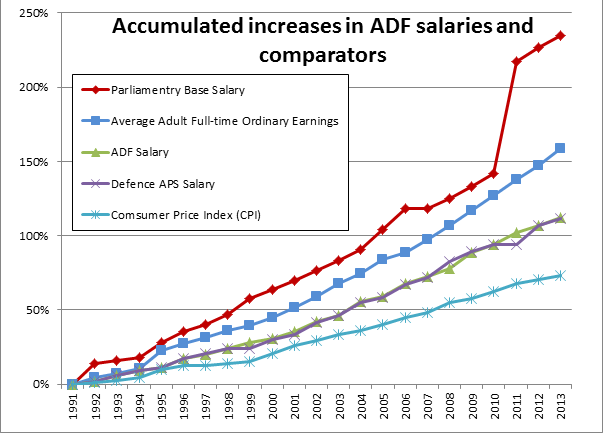 The government’s offer of a 1.5% p.a. pay rise for each of the next three years in exchange for a reduction in leave entitlements and other allowances has been met with dismay. This is one of those issues where the facts speak for themselves. So here are some facts:
The government’s offer of a 1.5% p.a. pay rise for each of the next three years in exchange for a reduction in leave entitlements and other allowances has been met with dismay. This is one of those issues where the facts speak for themselves. So here are some facts:
According to the government’s own figures, inflation is projected to be 2.25% in 2014-15 and 2.5% for the three years after. With a little arithmetic, this means that the government’s offer of 1.5% per annum would result in a cumulative reduction of 2.66% in real terms over the next 36 months. Compared with the remainder of the labour force, the picture is worse still. The government projects that the Wage Price Index will run at 3% over the next two years.
Two things are noteworthy in this regard. First, the Defence budget is indexed at 2.5% per annum to take account of inflation. Second, the ADF workforce has been quarantined from efficiency dividends under the current and previous governments. It follows that an inflation-matching salary increase of 2.5% per annum could be afforded from within existing funding without redirection from other programs (consistent with the government’s 2014 Public Sector Workplace Bargaining Policy).
Current ADF salary rates and allowances can be found here. For those without the time to work through the labyrinth of numbers, a benchmark is as a follows. The salary plus service allowance for a sergeant in the army roughly equates with average adult full-time earnings in Australia (~$78,000). Higher ranks get paid more, lower ranks less—though specialist skills can make a significant difference.
Looking over time (see chart above), ADF salary increases have consistently outpaced inflation; and growth in average weekly full-time ordinary earnings has done the same, but by a wider margin. The latter is presumably a reflection of a structural shift in the Australian economy to higher productivity jobs. Defence APS salaries and ADF salaries are bootstrapped onto each other, thereby explaining their overlapping trajectories.
Finally some context is worth taking into account. The government has frozen the pay of parliamentarians and senior public servants as of July 1 2014, so they’ll experience an even higher percentage real loss of salary than ADF members if the present offer goes through. However, this needs to be seen in the context of the 31% pay increase awarded to parliamentarians in 2012 (along with the 27% increase in remuneration awarded to the Chief and the Defence Force and a similar rise for departmental secretaries over the period 2012 to 2014).
As I said, the facts speak for themselves.
Mark Thomson is senior analyst for defence economics at ASPI. Image (c) ASPI 2014.